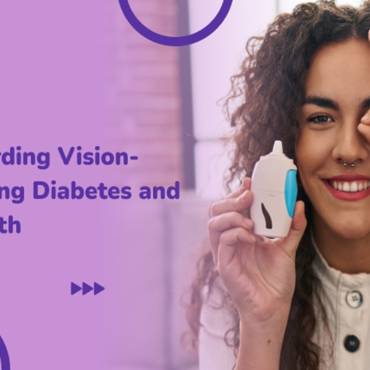Digital eye strain is a growing public health concern and one of the most common reasons for seeking medical attention. This article aims to provide an overview of digital eye strain, with a particular focus on symptom management and eye care. It is believed that as many as 90 % of users of digital devices experience symptoms of digital eye strain.
What is digital eye strain?
Digital eye strain is a condition characterized by visual disturbances or ocular discomfort associated with the use of computing devices, resulting from a range of stresses on the eyes, including dry eyes, foreign body sensation, itching, headache, blurring of vision, and watery eyes. Non-ocular eye strain symptoms arising from the prolonged use of computing devices include general fatigue, a stiff neck, headaches, and backaches. According to a recent research study, about 65% of American adults experience some digital eye strain after prolonged use of electronic devices. Furthermore, people in the US are now believed to spend 60 hours a week accessing content, and ophthalmologists are increasingly called upon to manage such patients.
Causes of digital eye strain
Common causes of digital eye strain include activities that involve prolonged concentration on computer screens, laptops, or smartphones. One of the common causes of eye strain is computer vision syndrome. This usually occurs when you use a computer for an extended period. Other possible causes of eye strain are:
-
- Activities that require complete focus and concentration for a prolonged period
- Working on screens in a dim light environment
- Exposure to bright lights.
- The eye muscles have trouble focusing on near work.
- Needing glasses or updating the prescription number.
These causes can give rise to symptoms such as eye pain, blurred or double vision, tired eyes, dry eyes, watery eyes, burning eyes, and light sensitivity.
Management strategies
Continuous staring at the screen can lead to a significant reduction in blink rate, ultimately resulting in dry eye-related problems. One of the most common reasons for dry eyes is the use of smartphones rather than other digital devices. Working on computer screens requires continuous focusing and refocusing to maintain clear vision. The frequent eye movements required to maintain focus can lead to eye strain and fatigue. A constant convergence, a shorter distance between the digital screen and your eyes, and accommodative demand can further worsen the symptoms associated with digital eye strain. Using the screen for a prolonged duration (more than four hours), inadequate lighting, and improper posture have a direct association with digital eye strain. Screen time has also been linked to an increased risk of myopia (near-sightedness) progression. It is important to prevent myopic progression due to the associated risks of retinal detachment, myopic macular degeneration, cataracts, and glaucoma.

Tips for easing eye strain include the ergonomic use of digital devices:
-
- Reduce the average daily screen time to a reasonable limit.
- Incorporate digital device practices, which include positioning the device correctly, maintaining a proper lighting environment, adjusting imaging parameters, and taking frequent breaks from the screen. The 20/20/20 method (after 20 minutes of visual display use, looking at projects over 20 feet away for 20 seconds) is one of the popular recommendations for reducing digital eye symptoms.
- It is advisable to sit upright at a desk or table with screens positioned around 20 inches from the eyes. Ensure the screen is positioned lower than the height of the eyes, with a viewing distance of 15 to 20 degrees below your eye level. Blinking frequently minimizes the chances of developing dry eyes.
- An illumination of over 1000 lx is believed to reduce the user’s performance. Most people are comfortable with a contrast setting of about 60 to 70%. Adjust the brightness so that the light from the monitors matches the ambient light in the surrounding workspace. Wearing anti-glare glasses or using an anti-glare screen can also help reduce the amount of light reflected from your digital device. Choose a font of at least size 12, preferably in a dark colour on a light-coloured background.
- Consider tracking your screen time to control excessive screen usage. This encourages spending less time on smartphones or computer screens.
- Refractive error correction is a process that aims to restore clear vision by changing the way light focuses on the retina. This can be done through various methods, including contact lenses and eyeglasses.
- It is essential to be well-informed about the long-term effects of excessive screen usage and to promote healthier lifestyle habits.
- Patients should monitor their child’s screen time and encourage more family time.
- Encourage your kids to participate in outdoor activities.
There is strong evidence that shows increased screen time is associated with an increased risk of unhealthy diets, poor interpersonal relationships, cognitive decline, and a decline in quality of life among young children and adolescents. Over the last decade, the use of digital electronic devices among children and adolescents has increased significantly. Therefore, parents and youth should be aware of the benefits of limiting screen time and adopting ergonomic practices to minimize exposure to screens.
Summary
Prevention is the primary strategy for managing digital eye strain. The first step should be to have an eye examination to treat visual disorders (if any). Digital eye strain treatment also includes creating an ergonomic work environment and practising techniques that can be achieved through patient education and implementing these useful tips at the workplace.
Special consideration is given to individuals with a high risk of digital strain, such as computer workers and individuals who wear contact lenses. Additional suggestions include maintaining normal blinking, improving contact lens comfort, using artificial tears, and utilizing tinted correction options (such as blue light filters).



